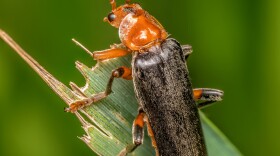After a long day, on a night when nobody is in the mood to cook, you might decide to order for delivery.
For insects, it’s not quite that easy. So what’s the next best thing? Have yourself delivered to your food.
Dull black in color …only about a centimeter in length …and with a particularly tough exoskeleton, there are more than 30 different species of Anteater Scarab Beetles in the United States.
As you might have already guessed from their common name, the adult beetles feed on ants. And while a variety of ant species are on the menu, the beetles have a preference for Thatching Ants – the species of ants that build large mounded nests.
Specifically, it’s not the adult ants that the beetles are after. Instead, they prefer to dine on the ant larvae – not an easily accessed source of food as ants are very capable defenders of their colonies.
So, how exactly do these uninvited guests get safely inside an ant nest that’s defended by thousands of guardians?
You might say, the beetles are dying to get inside this exclusive place to eat.
An adult beetle will position itself within the area that a colony’s worker ants are energetically patrolling, looking for dead insects (or live insects they can overcome) to drag back to feed the rest of the colony.
With a convincing, Oscar-winning performance, the worker ants find the presumably deceased beetle and drag it back to the nest.
And …scene! Once inside, the beetle miraculously comes back to life. Covered with the ants’ scent, it’s thought that the beetle can now move about the nest undetected as the larval predator it really is.





